Picture this: you’re standing in your backyard, marveling at a giant watermelon so massive it could steal the show at any state fair. The sweet, juicy flesh is a testament to your gardening prowess, and your neighbors can’t stop talking about it! Growing a giant watermelon isn’t just a fun project—it’s a rewarding journey that combines science, patience, and a love for plants. Whether you’re a seasoned gardener or a curious beginner, this guide will walk you through every step to cultivate a colossal fruit that’s both impressive and delicious. In this comprehensive article, we’ll cover everything from choosing the right seeds to harvesting a record-breaking giant watermelon, ensuring you have the tools and knowledge to succeed. With expert insights and practical tips, you’ll be ready to grow a showstopper in your own garden. 🌞
As a horticulture expert with over a decade of experience in fruit cultivation, I’ve helped countless gardeners achieve their dreams of growing oversized produce. This guide draws on proven techniques, scientific principles, and real-world success stories to ensure your giant watermelon thrives. Let’s dive into the world of massive melons and unlock the secrets to gardening glory! 🏆
Understanding Giant Watermelons: What Makes Them Special? 🌟
The Science Behind Giant Watermelons
Giant watermelons are a marvel of plant genetics and careful cultivation. Unlike standard watermelons, which typically weigh 10–20 pounds, giant varieties can tip the scales at 100 pounds or more. This is due to selective breeding for traits like rapid cell expansion and high water retention. Varieties like ‘Carolina Cross’ and ‘Black Diamond’ are engineered to produce massive fruits under optimal conditions. The key is maximizing photosynthesis and nutrient uptake to fuel growth, which requires a balance of sunlight, water, and soil fertility. According to Dr. Emily Thornton, a horticulturist at the University of Georgia, “Giant watermelons are a testament to how precise care can amplify a plant’s genetic potential.”
Benefits of Growing Giant Watermelons
Why go big? Beyond the bragging rights, growing a giant watermelon is a fun challenge that sharpens your gardening skills. It’s a great way to engage with local gardening communities or even enter competitions, like those hosted by state fairs or the Great Pumpkin Commonwealth (which also oversees watermelon weigh-offs). Plus, a single giant watermelon can feed a crowd, provide juice for days, or become a centerpiece for summer gatherings. Nutritionally, watermelons are packed with vitamins A and C, making them a healthy treat. Their vibrant appearance also adds aesthetic appeal to your garden. 🌿
Expert Insight: “Growing giant watermelons is like running a marathon—it takes dedication, but the finish line is worth it,” says John Harper, a competitive grower with multiple award-winning melons.
Choosing the Right Giant Watermelon Variety 🧬
Top Varieties for Giant Watermelons
Not all watermelons are created equal when it comes to size. Here are some top varieties known for their giant potential:
- ‘Carolina Cross’: The gold standard, capable of exceeding 200 pounds under ideal conditions. It thrives in warm climates with a 90–100-day growing season.
- ‘Black Diamond’: Known for its dark rind and sweet flesh, this variety can reach 100 pounds with proper care.
- ‘Georgia Rattlesnake’: A Southern favorite with a striped rind, often hitting 75–100 pounds.
When choosing a variety, consider your climate and growing season. For example, ‘Carolina Cross’ needs a long, hot summer, making it ideal for USDA zones 7–10. If you’re in a cooler region, opt for a faster-maturing variety like ‘Black Diamond.’

Where to Source Quality Seeds
High-quality seeds are the foundation of a giant watermelon. Purchase from reputable suppliers like Burpee, Johnny’s Selected Seeds, or Baker Creek Heirloom Seeds, which offer certified giant watermelon varieties. Check for seed freshness (look for harvest dates within the last year) and avoid generic or unverified sources. To test seed viability, soak a few in water—if they sink, they’re likely viable. Local agricultural extension offices can also recommend regional suppliers.
Example: Sarah, a gardener from Texas, grew a 180-pound ‘Carolina Cross’ watermelon after sourcing seeds from a trusted heirloom seed bank. Her success came from verifying seed quality and following a strict care regimen.
Preparing Your Garden for Giant Watermelon Success 🌍
Soil Requirements and Preparation
Giant watermelons demand rich, well-draining soil with a pH of 6.0–6.8. Test your soil using a home kit or send a sample to your local extension service. Amend with organic matter like compost or aged manure to boost nutrient levels. A good mix is 50% garden soil, 30% compost, and 20% sand or perlite for drainage. Incorporate 2–3 inches of organic matter into the top 12 inches of soil. Avoid heavy clay soils, which can cause root rot. For optimal results, add a slow-release fertilizer high in nitrogen (e.g., 10-10-10) before planting.
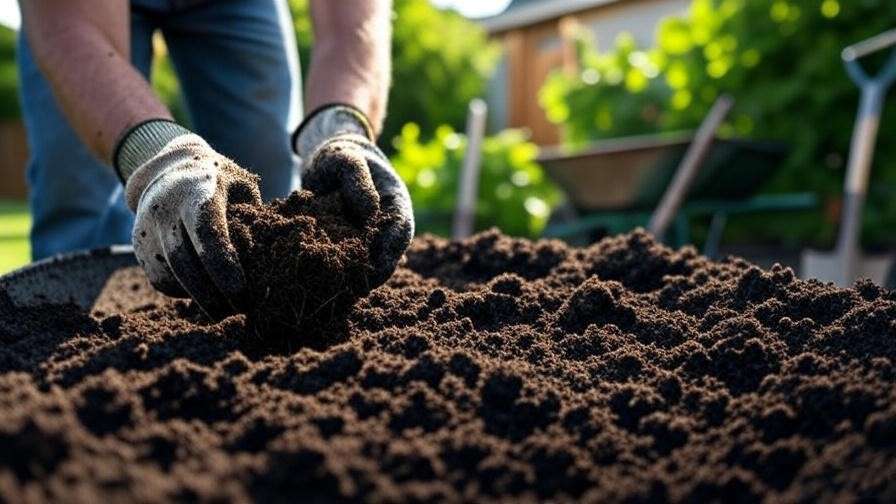
Site Selection and Space Planning
Choose a sunny spot with at least 8 hours of direct sunlight daily—giant watermelons are sun-worshippers! Each plant needs 20–30 square feet to accommodate sprawling vines. If space is limited, consider trellising vines vertically, but you’ll need sturdy supports for heavy fruit. Clear the area of weeds and debris to reduce competition. For fruit protection, place straw or cardboard under developing melons to prevent rot and pest damage.
Expert Tip: Use a soil test kit from your local garden center to confirm pH and nutrient levels before planting. Adjust with lime (to raise pH) or sulfur (to lower pH) as needed.
Planting Giant Watermelon Seeds 🌱
When and How to Plant
Timing is critical. Plant seeds in spring after the last frost, when soil temperatures reach at least 70°F (21°C). For most USDA zones, this is late April to early June. Sow seeds 1 inch deep, 3–4 feet apart, in rows spaced 6–8 feet apart. Plant 2–3 seeds per hill and thin to the strongest seedling after germination (7–10 days). Water gently after planting to avoid displacing seeds.
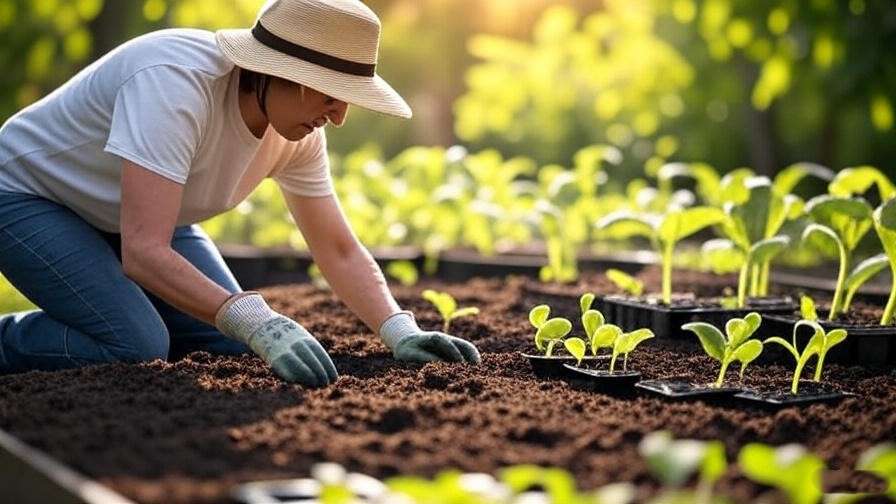
Starting Seeds Indoors vs. Direct Sowing
In cooler climates, start seeds indoors 3–4 weeks before the last frost. Use biodegradable pots to minimize root disturbance during transplanting. Keep seedlings under grow lights or in a sunny window at 75–85°F. Harden off plants by gradually exposing them to outdoor conditions over 7–10 days. Direct sowing is simpler in warm climates but riskier if temperatures drop.
Checklist:
- Seed trays or pots
- Heat mat for germination
- High-quality potting mix
- Watering can with a fine rose
Caring for Giant Watermelon Plants 🌿
Watering and Irrigation Needs
Giant watermelons need consistent moisture—1–2 inches of water per week, depending on weather. Use drip irrigation or soaker hoses to deliver water directly to the root zone, reducing leaf wetness and disease risk. Water deeply in the morning to allow foliage to dry by evening. Avoid overwatering, which can cause fruit splitting. During fruit development, monitor soil moisture with a meter to maintain even hydration.
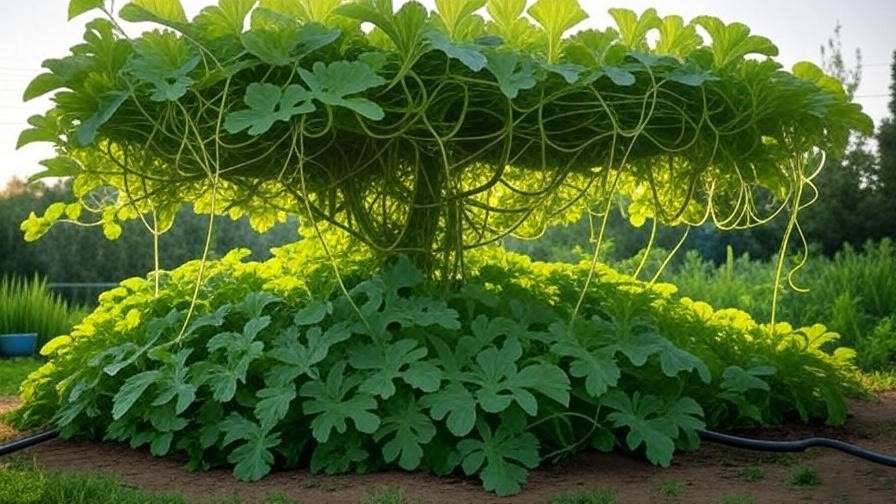
Fertilizing for Maximum Growth
Start with a nitrogen-rich fertilizer (e.g., 10-5-5) to promote leafy growth during the vegetative stage. Switch to a potassium-heavy blend (e.g., 5-10-15) once flowers appear to support fruit development. Apply liquid fertilizers like compost tea or fish emulsion every 2 weeks. Over-fertilizing can lead to excessive vine growth at the expense of fruit, so follow package instructions.
Pruning and Vine Management
To focus energy on a single giant fruit, prune secondary vines after the main vine sets 1–2 fruits. Remove smaller fruits to channel nutrients to the primary melon. Support developing fruit with slings made from old T-shirts or netting, securing them to a trellis or stake. Rotate fruits weekly to ensure even growth and prevent flat spots.
Expert Insight: “Pruning is key to giant watermelons. By limiting the plant to one fruit, you’re directing all its resources to size,” says Maria Gonzalez, a competitive grower from California.
Pollination and Fruit Development 🐝
Ensuring Successful Pollination
Pollination is critical for giant watermelon production, as it triggers fruit development. Watermelons rely on bees and other pollinators to transfer pollen from male to female flowers. To attract pollinators, plant companion flowers like marigolds or zinnias near your watermelon patch. If pollinator activity is low (e.g., due to weather or location), hand-pollination ensures success. Identify male flowers (thin stalk, no swelling at base) and female flowers (small swelling at base). Gently brush pollen from a male flower onto a female flower using a small paintbrush or cotton swab. Perform this early in the morning when flowers are open. Monitor for fruit set within 3–5 days.
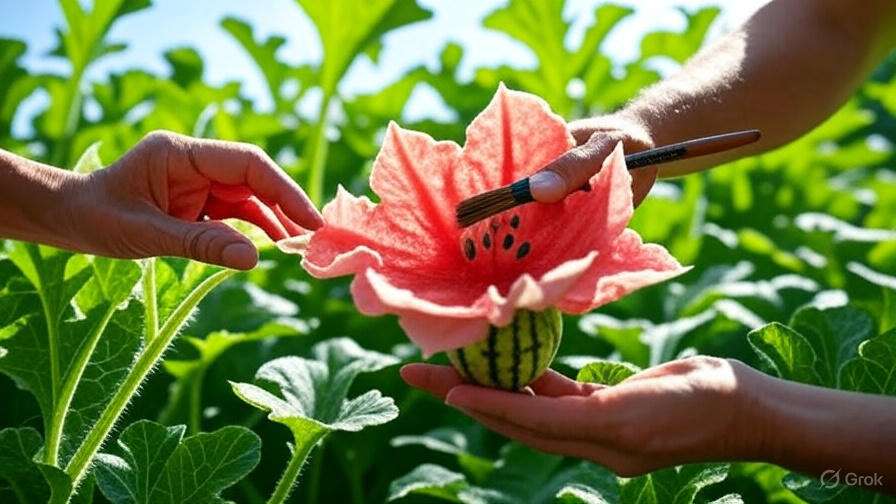
Selecting and Supporting the Prize Fruit
Once pollination occurs, select one or two healthy fruits per plant to focus energy on achieving giant size. Choose fruits that are well-formed, free of blemishes, and located on strong vines. Remove other fruits to prevent resource competition. As the watermelon grows, protect it from ground contact to avoid rot. Place a layer of straw, cardboard, or a breathable fabric like burlap under the fruit. For extra support, create a sling using pantyhose or soft netting, tying it to a sturdy trellis or stake. Check slings weekly to ensure they’re not cutting into the rind as the fruit expands.
Tip: Rotate your watermelon every few days to promote even growth and prevent misshaping. Use a marker to track progress by noting size increases weekly.
Common Challenges and How to Overcome Them 🚫
Pests and Diseases
Giant watermelons are vulnerable to pests and diseases, but proactive management keeps them healthy. Common pests include:
- Aphids: These sap-suckers weaken vines. Spray with neem oil or insecticidal soap, avoiding blooms to protect pollinators.
- Cucumber Beetles: These striped pests spread bacterial wilt. Use row covers early in the season and remove them during flowering.
- Powdery Mildew: White patches on leaves signal this fungal disease. Apply a sulfur-based fungicide or a milk-water solution (1:9 ratio) weekly.
Regularly inspect plants for signs of trouble, especially under leaves and near the fruit. For organic control, introduce beneficial insects like ladybugs. If using chemicals, follow label instructions and avoid spraying during pollination periods.
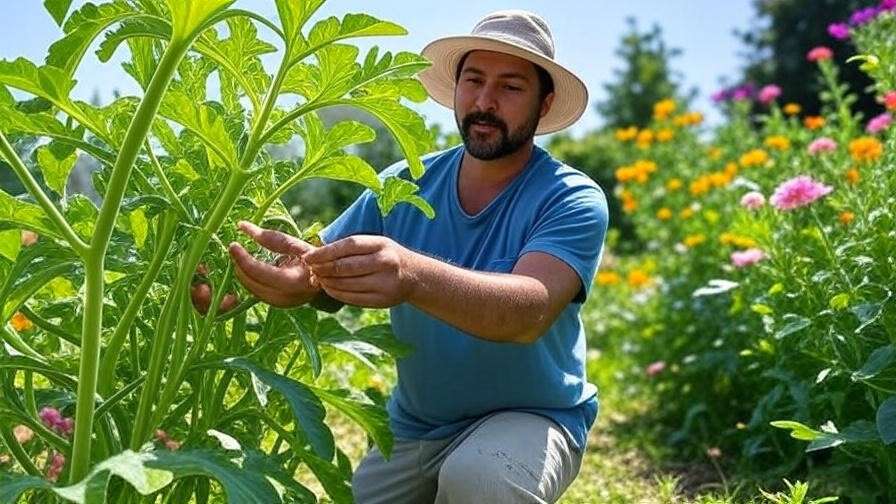
Environmental Stressors
Weather can challenge giant watermelon growth. Heatwaves above 90°F can stress plants, so provide afternoon shade with breathable cloth. During drought, increase irrigation to maintain consistent soil moisture. Heavy rain can cause fruit splitting—use mulch to regulate soil moisture and avoid overwatering. Blossom-end rot, marked by dark spots on the fruit’s base, results from calcium deficiency or uneven watering. Correct this by adding calcium-rich amendments like gypsum and maintaining steady irrigation.
Example: In 2023, a North Carolina gardener overcame blossom-end rot by adjusting watering schedules and applying crushed eggshells to the soil, resulting in a 150-pound watermelon.
Harvesting and Showcasing Your Giant Watermelon 🎉
When to Harvest
Timing the harvest is crucial to balance size and flavor. Look for these ripeness indicators:
- Yellowing Underside: The spot where the watermelon rests on the ground turns creamy yellow.
- Dull Rind: The rind loses its glossy sheen.
- Thumping Sound: A ripe watermelon produces a hollow “thunk” when tapped.
Harvest typically occurs 80–100 days after planting, depending on the variety. For competitions, delay harvesting as long as possible (without risking rot) to maximize size. Use sharp shears to cut the stem 2 inches above the fruit, avoiding damage to the rind.
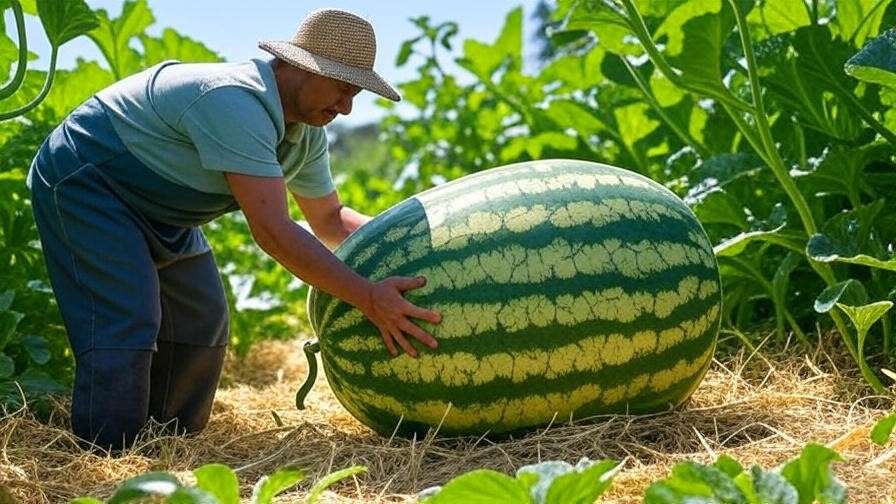
Storing and Using Your Watermelon
Store your giant watermelon in a cool, dry place (50–60°F) for up to a month. Avoid stacking or crowding to prevent bruising. For immediate use, slice into manageable pieces for juicing, salads, or desserts. A single giant watermelon can yield gallons of juice or feed dozens at a community event. Consider donating excess to local food banks or sharing with neighbors to build community goodwill.
Expert Tip: To weigh your watermelon for competitions, use a heavy-duty scale or visit a local feed store with industrial scales. Record measurements (circumference and weight) for bragging rights!
Competing with Your Giant Watermelon 🏆
Entering Local or National Competitions
Giant watermelon competitions, like those at state fairs or the Great Pumpkin Commonwealth, offer a chance to showcase your skills. Research events in your area and review rules, which often require pre-registration and specific weighing protocols. Prepare your watermelon by cleaning the rind and ensuring it’s free of cracks. Transport carefully using a padded trailer or truck bed to avoid damage. At the event, network with other growers to exchange tips and seeds.
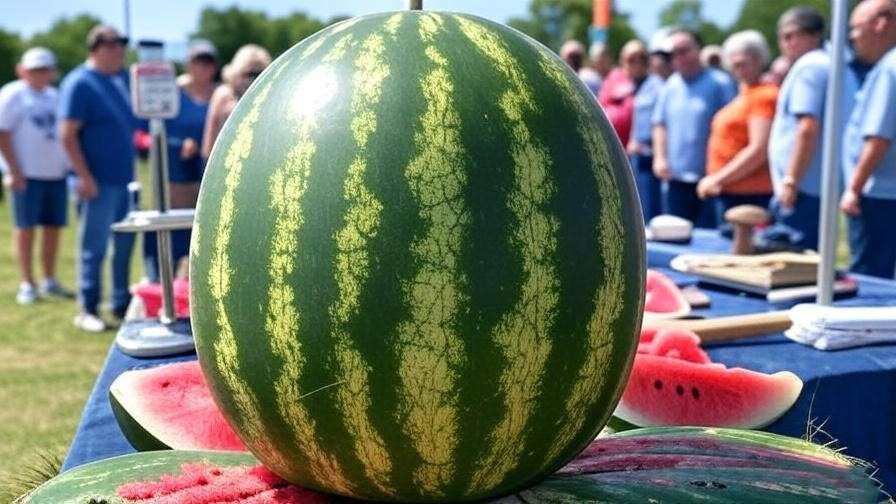
Building Community Around Giant Watermelons
Growing a giant watermelon is a conversation starter! Join local gardening clubs or online forums like the Giant Watermelon Growers Network to share your journey. Post progress photos on social media with hashtags like #GiantWatermelon or #BigMelon to inspire others. Host a “watermelon weigh-off” party to engage your community and celebrate your harvest. Sharing seeds from your best melons can foster connections and encourage others to try growing giants.
Case Study: In 2024, a Virginia grower named Tom broke his local fair’s record with a 210-pound ‘Carolina Cross.’ His strategy? Consistent pruning, a custom nutrient blend, and daily monitoring of soil moisture. Tom shared his seeds with neighbors, sparking a local giant watermelon craze.
FAQs About Growing Giant Watermelons ❓
Q1: How long does it take to grow a giant watermelon?
A: Most giant varieties take 80–100 days from planting to harvest, depending on climate and care.
Q2: Can I grow giant watermelons in containers?
A: It’s challenging due to space needs, but possible with large (50-gallon) containers, trellising, and diligent care.
Q3: What’s the biggest watermelon ever grown?
A: The Guinness World Record is a 350.5-pound watermelon grown by Chris Kent in Tennessee in 2013.
Q4: How do I prevent pests without harming pollinators?
A: Use targeted organic sprays like neem oil after pollination hours and introduce beneficial insects.
Q5: Do giant watermelons taste as good as regular ones?
A: Yes, when grown properly, they’re just as sweet and juicy, though texture may vary slightly.
Conclusion
Growing a giant watermelon is a thrilling adventure that combines science, skill, and a touch of patience. From selecting the perfect variety like ‘Carolina Cross’ to mastering soil prep, watering, and pruning, every step brings you closer to a backyard masterpiece. By overcoming challenges like pests and environmental stress, you’ll not only harvest a massive fruit but also gain invaluable gardening expertise. Whether you’re aiming for a local competition or simply want to impress your neighbors, this guide equips you with everything you need to succeed. Start planting today, share your progress with #GiantWatermelon, and let your garden shine! 🍉












